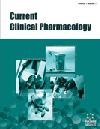- Home
- A-Z Publications
- Current Clinical Pharmacology
- Previous Issues
- Volume 7, Issue 2, 2012
Current Clinical Pharmacology - Volume 7, Issue 2, 2012
Volume 7, Issue 2, 2012
-
-
Ciclesonide - A Novel Corticosteroid for the Management of Asthma
More LessAuthors: Deepti Chopra, Bharti Bhandari and Neeta WardhanCiclesonide (CIC) is a novel inhaled corticosteroid (ICS) approved by US Food and Drug Administration for the treatment of persistent asthma, available as a pressurized metered-dose inhaler in two strengths, 80 mcg/activation and 160 mcg/activation. Ciclesonide is a corticosteroid with unique pharmacological profile including a high degree of serum protein binding, a low oral bioavailability and rapid systemic elimination Read More
-
-
-
Pharmacogenetics and Anesthetic Drugs
More LessThe incidence and potential for serious adverse drug reactions (SADRs) in anesthesia are high due to the narrow therapeutic indices of anesthetic and analgesic drugs and high interindividual variability in drug responses. Genetic factors contribute to a majority of these SADRs. Pharmacogenetics (PG), the study of genetic effects on drug action, is strongly related to the field of anesthesia; historically, succinylcho Read More
-
-
-
Current Status of CETP Inhibitors in the Treatment of Hyperlipidemia: An Update
More LessAuthors: Raktim Kumar Ghosh and Samhati Mondal GhoshIntroduction: The inverse relationship between HDL-C and cardiovascular disease risk suggests that increasing HDL-C could potentially reduce the disease risk. Reverse cholesterol transport is considered to be the primary mechanism by which HDL-C exerts its anti-atherogenic effects. A key regulator of RCT is cholesteryl ester transfer protein (CETP). Areas Covered: Inhibition of CETP has been identified as a possible strategy Read More
-
-
-
Adherence to Antiretroviral Therapy Among Iranian HIV/AIDS Patients
More LessPurpose: Treatment adherence of 95% or higher is recommended for appropriate therapeutic response and improving the function of immune system in HIV positive patients. To the best of our knowledge, there was report of adherence to HAART regimen from Iran. In the present study, we have reported the HAART adherence rate of Iranian HIV positive patients. Method: In a twelve-month period, all patients older than 18 y Read More
-
-
-
Breakthrough Pain-Novel Analgesics
More LessAuthors: Seema Randive and Vivek MehtaBreakthrough pain (BTP) is a transitory exacerbation of pain that occurs on a background of otherwise controlled pain. It is associated in conjunction with severe chronic pain and may result in impaired physical and psychological functioning, reduced effectiveness to opioids and also, increased financial burden. It manifests commonly in malignant pain, as manifested by well managed round the clock regular opioid me Read More
-
-
-
Polyethylenimine as a Promising Vector for Targeted siRNA Delivery
More LessRecent discovery of RNA interference (RNAi) technology for gene therapy has triggered explosive research efforts towards development of small interfering RNA (siRNA) as therapeutic modality for gene silencing. Owing to its large molecular weight (∼13 kDa), polyanionic nature (∼40 negative phosphate groups) and rapid enzymatic degradation, delivery of siRNA remains an unresolved issue. Hence, there arises a need of an a Read More
-
-
-
Oral Beclomethasone Dipropionate: A Critical Review of its Use in the Management of Ulcerative Colitis and Crohn’s Disease
More LessCrohn's disease and ulcerative colitis are inflammatory bowel diseases characterised by a chronic relapsing course. Corticosteroids represent the mainstay of medical treatment of inflammatory bowel disease for the induction of remission. Despite the high efficacy of systemic steroids, their use is limited by the high incidence of potentially serious adverse effects. The topically acting steroids are synthetic compounds charact Read More
-
-
-
Application of Monoclonal Antibodies as Cancer Therapy in Solid Tumors
More LessAuthors: Rodrigo Dienstmann, Ben Markman and Josep TaberneroMonoclonal antibodies have become an important new class of therapeutic agents approved for use in solid tumors. They function through several different mechanisms including inhibition of tumor-related signal transduction, induction of apoptosis, inhibition of angiogenesis, enhancing host immune response against cancer and targeted delivery of cytotoxic agents to the tumor site. Several monoclonal antibodies have now r Read More
-
Volumes & issues
Most Read This Month
Article
content/journals/ccp
Journal
10
5
false
en


